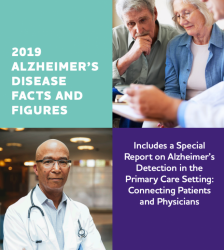
Alzheimer’s disease is a type of brain disease, just as coronary artery disease is a type of heart disease. It is also a degenerative disease, meaning that it becomes worse with time. Alzheimer’s disease is thought to begin 20 years or more before symptoms arise,1-6 with
small changes in the brain that are unnoticeable to the person affected. Only after years of brain changes do individuals experience noticeable symptoms, such as memory loss and language problems. Symptoms occur because nerve cells (neurons) in parts of the brain
involved in thinking, learning and memory (cognitive function) have been damaged or destroyed. Individuals typically live with Alzheimer’s symptoms for years. Over time, symptoms tend to increase and start interfering with individuals' ability to perform everyday activities. At this point, the individual is said to have dementia due to Alzheimer's disease, or Alzheimer's dementia. As the disease progresses, neurons in other parts of the brain are damaged or destroyed. Activities that used to be core to the individual’s identity, such as planning family events or participating in sports, may no longer be possible. Eventually, neurons in parts of the brain that enable a person to carry out basic bodily
functions, such as walking and swallowing, are affected. People in the final stages of Alzheimer’s disease are bed-bound and require around-the-clock care. Alzheimer’s disease is ultimately fatal.
| Allegato | Dimensione |
|---|---|
| 1.93 MB |

